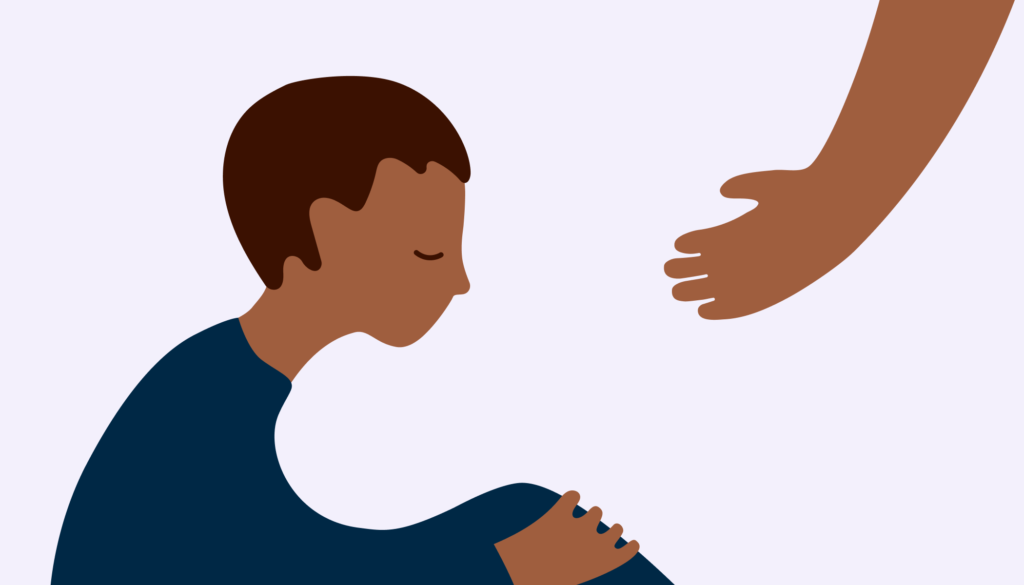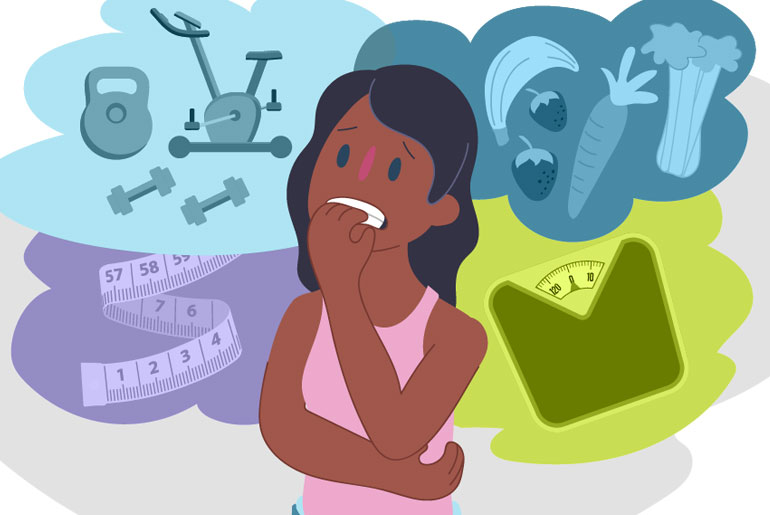Eating disorders
Eating disorders are not a diet gone too far, or a new lifestyle to attempt. All types of eating disorders including anorexia nervosa, bulimia, and binge eating disorder are serious, complex, and life-threatening mental illnesses.
Eating disorders mostly affect women between the ages between 12 and 35. And although may affect any gender at any age.
Causes of eating disorder
Eating disorders are extremely difficult diseases. We still don’t fully comprehend their origins. Numerous elements are at play, including social environment, genetic and biological characteristics, and mental health. Each person’s motivations are unique.
The following are some causes that may lead to having an eating disorder:
- bad body image and low self-esteem
- social issues with thin-shaming Managing stress, bullying, difficulties in friendships and/or family connections, and trauma
- Not engaging in a sport or activity where size or weight is heavily emphasized (modeling, ballet, gymnastics, wrestling)
- diabetes type 1
Risk factors

The following are some risk factors for developing an eating disorder:
Any race, age, or socioeconomic class can be impacted by eating disorders. Genetic factors influence at home or at school, the person’s personality, the existence of specific psychological problems, cultural pressures, or a number of biological characteristics are risk factors that raise the possibility of having an eating disorder.
genetic
According to research, genetic variables may make it more likely for someone to develop an eating issue. People who have a first-degree relative with an eating disorder history are more likely to acquire an eating disorder than people who don’t have such a relative.
Additionally, particular genes that affect hormones like leptin and ghrelin have been found by researchers. According to experts, in addition to controlling appetite, these hormones may also have an impact on the personality traits and behaviors linked to anorexia and bulimia.
Personality
Low self-esteem, perfectionism, approval seeking, dependency, and issues with self-direction are just a few of the personality and behavioral features that are frequently found in people with eating disorders.
Additionally, certain personality disorders, such as avoidant personality disorder, obsessive-compulsive personality disorder, borderline personality disorder, and narcissistic personality disorder, can raise the chance of developing eating disorders.
People with avoidant personality disorder tend to be perfectionists, emotionally and sexually reserved, non-rebellious, and fearful of ridicule or criticism.
People who suffer from an obsessive-compulsive personality disorder may be perfectionists, ethically strict, or excessively preoccupied with rules and order.
The disorder known as borderline personality disorder is linked to self-
An inability to soothe oneself or empathize with others, as well as a desire for praise and excessive sensitivity to criticism or failure, are all characteristics of narcissistic personality disorder.
Psychiatric changes
Atypical eating behaviors have been linked to psychological disorders such as post-traumatic stress disorder (PTSD), panic disorder, phobias, and melancholy, as well as life stressors like job loss, divorce, dealing with bullying, and learning disabilities like dyslexia.
An eating disorder may develop as a result of stressful or traumatic circumstances, such as meeting deadlines at work, school, or university, losing a loved one, and suffering tight deadlines.
Issues with body image
Body image issues like body dysmorphic disorder, in which a person has a skewed perception of their body, or muscle dysmorphia, which is defined as a fixation with muscular bulk, are frequently linked to anorexia or bulimia.
Pressures from culture
The influence of the media on Western culture might foster an obsession or desire for thinness. The idea of being thin, particularly among young girls, may be fostered and encouraged by the media because thinness or slimness is frequently associated with success and attractiveness.
But the media also aggressively promotes cheap, calorie-dense foods, which can be confusing and stressful. People who participate in competitive or athletic activities like modeling, ballet, or running may also feel pressure to lose weight. Because of this, some people may have irrational expectations about their physical appearance and overemphasize the value of being skinny.
Biological aspects
The hypothalamic-pituitary-adrenal axis (HPA), a physiological system, may be crucial in eating disorders. Serotonin, norepinephrine, and dopamine are among the mood, stress, and stress-related hormones that are released by the HPA. These chemical messenger abnormalities are thought to be a major factor in eating disorders.
Serotonin is crucial for controlling appetite and anxiety, whereas norepinephrine manages stress, and dopamine is involved in behavior that seeks rewards. People with anorexia may not feel pleasure from food or other everyday comforts because of a serotonin and dopamine imbalance.
10 types of eating disorders
1- Anorexia Nervosa
Despite having the most prominent appearance, anorexia can take many different forms and differs depending on the individual. In order to avoid gaining weight, people with classic anorexia nervosa will restrict their intake of calories or particular foods.
The bingeing and purging variations are also available. According to Weatherston-Yarborough, individuals with this type of anorexia frequently restrict their food intake or binge eat before engaging in purging behaviors such as self-induced vomiting, using laxatives, or engaging in excessive exercise.
According to the National Eating Disorder Association, in addition to the behavioral indicators, some concealed physical indications of anorexia include irregular or skipped periods, thinning hair, dry skin, or trouble sleeping.
2- Bulimia
Bulimia nervosa symptoms may not be as obvious as anorexia. A person with bulimia might exhibit behaviors resembling those of a person with binge-purge anorexia, such as consuming a lot of food and then purging it from the body.
But unlike anorexia, which frequently results in dramatic weight loss, bulimia does not, according to Weatherson-Yarborough.
If you have reason to believe that a person you know is battling with bulimia, search for any covert indications, such as empty food containers that could indicate binge eating, bottles of laxatives or diuretics, dental problems, or calluses on their knuckles from vomiting.
Of course, another blatant behavioral indicator of bulimia is running to the restroom right after every meal.
3- Binge eating disorder
Because the symptoms of a few common eating disorders can be so similar, making the diagnosis of an eating disorder can be difficult. Because the person may consume enormous amounts of food quickly and frequently covertly, a binge eating disorder might be mistaken for bulimia. But there’s a little distinction.
According to Weatherston-Yarborough, a person with a binge eating disorder often engages in restricting and bingeing behaviors but not in purging behaviors. Any weight might be affected by a binge eating disorder.
4- Muscle Dysmorphia
Muscle dysmorphia often affects more males than women, in contrast to the majority of eating disorders. An obsessive fixation with muscles and appearance, which is disruptive, is a feature of the illness. The person will become fixated on developing the “ideal” shape of musculature.
5- Compulsive Overeating (COE)
This condition resembles a binge eating disorder. The distinctive feature of COE is that the person consumes a lot of food all day long rather than bingeing sometimes.
6- Diabulimia
This happens when a diabetic person tries to lose weight by using the prescribed insulin.
7- Orthorexia Nervosa
We are all under pressure to eat healthy for a variety of reasons; this condition is known as orthorexia Nervosa (a term coined by author and physician Steven Bratman). When someone has orthorexia Nervosa, their obsession with organizing the ideal diet causes life-threatening complications.
8- Selective Eating Disorder
Similar to finicky eating, but on an extreme, crippling level, is this eating condition. A person becomes ill because they are so picky about their diet and usually only eat one or two meals per day.
9- Drunkorexia
This word, which has a very crude-sounding name, refers to an eating disorder that is also accompanied by drinking. To “save calories” for alcohol use, the anorexic person with a drinking problem restricts their food intake and purges. Untreated drunkorexia can result in severe malnutrition.
10- Pregorexia
Most women go into pregnancy with a weight loss strategy because it is fairly well known that pregnancy causes weight increase and other physical changes. The weight loss strategy may occasionally be too drastic, endangering both the mother and the unborn child.
Low birth weight, coronary heart disease, type 2 diabetes, stroke, hypertension, cardiovascular disease risk, and depression are all consequences of pregorexia.
Treatments for eating disorders

Common therapy objectives include regaining proper nutrition, achieving a healthy weight, cutting back on excessive exercise, and ceasing bingeing and purging.
Treatment programs frequently contain one or more of the following and are frequently customized to meet individual needs:
- Psychotherapy
- monitoring and medical care
- nutritional guidance
- Medications
Some patients could additionally require hospitalization to address malnutrition-related issues or to make sure they eat enough if they are severely underweight. It’s possible to heal fully.
Resources and references: MAYO CLINIC, WIKIPEDIA, healthline, NHS, American Psychiatric Association.


Leave a Reply